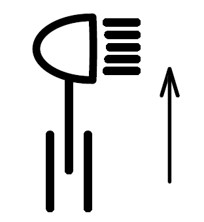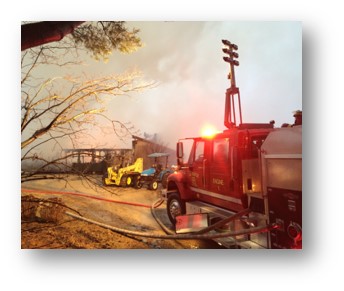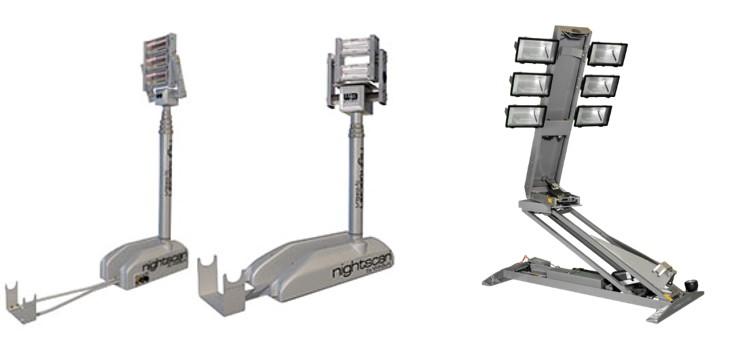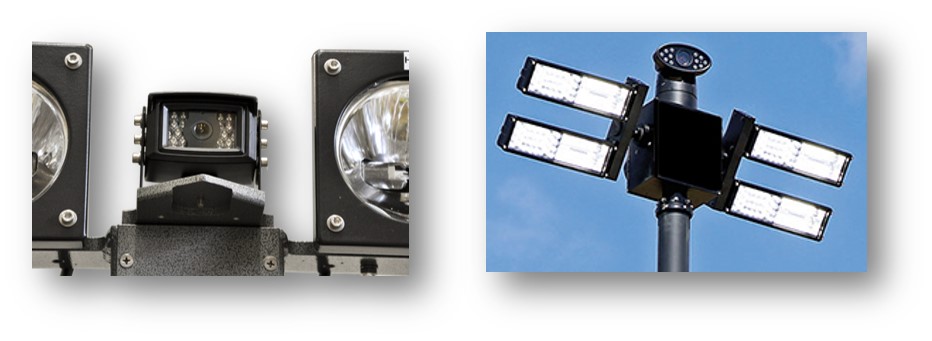Light Towers
FAMA BUYER’S GUIDE TC060 Light Towers
Prepared by the FAMA Electrical Subcommittee
This guide does not endorse any manufacturer or product

Contents
Introduction
Safety is the number one requirement when answering a call and nighttime operations create an even bigger challenge. Fire truck Light Towers create a safer work environment by lighting the scene from above, like natural daylight. To safely do a job at night, the best lighting possible is critical. High intensity, vehicle mounted light towers provide the illumination needed to safely complete nighttime rescue, disaster, or investigative operations.
As with any light tower there are advantages and disadvantages. This guide will describe many different things that you should consider before you choose the tower that will work best for your department. The different features and options discussed may not be available from every manufacturer.
Overview
Overhead lighting reduces glare for oncoming traffic and does not blind the crew. Light towers allow you to customize light intensity and coverage by stopping the tower at any height before it is fully extended. There are several things that should be considered when choosing the light tower that is right for your department. After reading this guide, you should have a much better idea of what you need and what you should ask for.

Types of Light
There are two types of light that are most commonly used on modern light towers. Halogen and LED. The most sophisticated and long-lasting LED lighting available in the market today is offered in low power consumption and high lumen output arrangements. Halogen packages are available for applications where traditional, lower initial cost lighting is required. Let’s look at Halogen lights first. There are definite advantages and disadvantages to halogen lighting.
HALOGEN
Pros:
- Lumens: Halogen light fixtures provide a higher raw lumen output than the brightest LED fixtures that are currently offered.
- Weight: Halogen light fixtures weigh less than LED’s. This will affect the overall weight of the tower which will be discussed later.
- Cost: This is one of the biggest advantages. Halogen fixtures on a light tower can significantly cut the cost of the tower. This tends to be a driving factor that keeps the halogen light technology alive.
Cons:
- Heat: Halogen fixtures get extremely hot! If the tower is not stowed properly these fixtures have been known to get hot enough to remove paint from the apparatus.
- Blown bulbs: The lamp itself is sensitive to oils left by human skin, if you touch the bulb with your bare hands the oil left behind will heat up once the bulb is activated, this oil may cause an imbalance and result in a failure of the bulb.
- Life Expectancy: Halogen lights only last an average of 250 hours. This means you will have additional maintenance costs of replacing bulbs.
LED
Now let’s take a look at LED’s. There are definite advantages and disadvantages to LED lighting.
Pros:
- Efficiency: LED’s alone are capable of outputting more than 200 lumens/watt. However, most fixtures are closer to 100 lumens/watt.
- Power Options: You also have multiple power options available between 12VDC, 24VDC, 120VAC and 240VAC. 12VDC and 24VDC allows you the option of eliminating a line voltage generator.
- Life Expectancy: LED’s have an average life of 50,000 hours. There are no maintenance costs associated with LED fixtures because there are no bulbs to change.
Cons:
- Cost: LEDs are more expensive, price per lumen, on an initial capital cost basis, than Halogen. However, over the life of the vehicle the cost of replacing multiple Halogen bulbs, will offset the cost savings.
- Weight: LED fixtures weigh about twice as much as Halogen fixtures. If you are considering adding cameras or anything else on top of your light tower, then the total payload could become an issue.
Tower Features
What do you want your tower to be able to do? Auto stow? Send light in two different directions? Get as high in the air as possible?
These are some of the questions that you will need to answer. Let’s take a look at some of the popular features available from most manufacturers.
- Height: How high do you want to go? Light towers are offered anywhere from 3ft to 30ft. Mountainous terrain or tall buildings might require a light tower of 30ft with six high-powered light fixtures. Smaller apparatus might be better suited with a 3ft model with two lamps.
- Light in Any Direction: Is being able to Illuminate 360˚ forward and backward equally important? This usually adds cost but if it’s important to your department then most manufacturers offer this feature. Consider a situation where you are positioned in the middle of a scene.
- Auto Stow and Deploy: Most manufactures offer a one or double touch feature that will allow the tower to deploy and stow with the simple press of a button.
- Number of light fixtures: How much light do you need? Two, four or six LED or halogen fixture options are available. Total lumens can reach 210,000.
- Strobe Lights: Compact strobe lights can be installed on most light towers for added visibility and safety. Strobes feature a rugged, impact-resistant polycarbonate dome and base, exceptional fiber optics, and a double-flash power supply that automatically adjusts to function at any voltage – from 12V to 24VDC. They should meet SAE J1318 Class 3 specifications and most are available in LED beacons and a variety of colors: amber, blue, clear, red and green.

Installation
When considering the installation of a new light tower, location is usually the most important thing to think about. How much space is available for the light tower? If ample roof space is available; a lightweight, compact, folding, roof-mounted tower is a good option. If space is tight, a through the body vertical light tower or side mounted vertical tower might be the best option.
Weight of the tower can also become an issue. Choosing a light tower that is lightweight will ensure that you will not have to reinforce the roof which will add cost to the installation. In addition, a lightweight tower will help to reduce fuel costs and free up capacity for other equipment.
Any conversation about installation of a light tower cannot be complete without discussing how you are going to power it. With the rise in popularity of LED light fixtures and their high efficiency, it is now possible to get a tower at any height that runs off of 12VDC or 24VDC which would eliminate the need for a generator. This in turn will save you money which will justify paying extra for LED lights. Light towers are also available in 120VAC and 240VAC. If you are already planning on having a generator on the apparatus you may opt for one of these options as the amp draw on a 120VAC tower or a 240VAC will be much less than a 12VDC or a 24VDC tower.
Controllers
When shopping for a controller, look for one that offers a range of full-function and is simple-to-use. It should be designed for rugged duty and gloved hands. It should also be impervious to even the harshest weather and operating conditions. Having an emergency stop button is required to meet NFPA standards so having that built into the controller is the perfect solution. When choosing a controller for your light tower you have three standard options: panel mount, handheld (wired) or wireless. The following are some things to think about when selecting the right controller for your tower.
Panel Mount:
- This gives you a centralized location for operating the tower.
- You will not have to worry about losing the controller.
Handheld (Wired):
- Flexibility to move around the vehicle to ensure you are raising the tower safely (most popular).
Wireless:
- Even more flexibility. No tether holding you back to move freely around the truck.
- Note: They tend to get lost or run over.
Combination (Handheld and Panel):
- Most manufacturers offer an option of having both a panel mount controller and a handheld controller. This will give you great flexibility in where you can be located while operating the tower.
Cameras
The concept of a camera on top of a light tower is not a new idea. In fact, light tower manufacturers have been putting cameras on towers for years but, recently they have gained popularity. This is primarily due to the advancements in camera technology and prices for HD cameras coming down.
A camera, elevated to a height from 3ft. to 30ft. above the vehicle roof, allows ground personnel to survey an emergency scene quickly and efficiently. In addition, the system offers real-time monitoring and surveillance for accurate record keeping and documentation. Departments around the world are using cameras on their towers for training and insurance purposes. There are several camera, DVR, monitor, and software packages that fit a variety of needs. There are also many different things to consider when choosing a camera package solution. Here are a few;
- Stationary or PTZ (Pan, Tilt, Zoom): A stationary camera will be fixed on the tower and only move when you move the tower. It has limited functionality but, you are able to get a stationary camera at the lowest price out of all of your camera options. PTZ stands allow you to control the camera independently of the tower. These cameras are great at seeing long distances.
- Resolution: The higher the resolution, the better the definition, clarity, and quality of the picture. Lower-resolution cameras produce images with less detail.
- VMS (Video Management System): Do you need a monitor or DVR? DVR’s are used for training and liability protection. Do you want the ability to access your camera system from any location or only when you are onsite and at the apparatus? Video can be transmitted via cellular or internet to remote locations. The type of VMS you will need will be based off of your answers to these questions.

Additional Resources
For more information, contact your apparatus manufacturer, or the FAMA light tower suppliers listed in the manufacturer’s guide at www.fama.org/members/list/.
